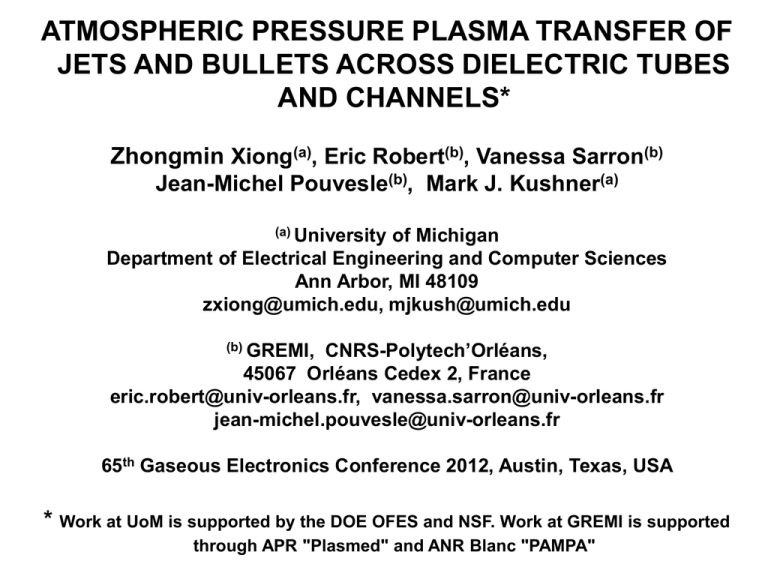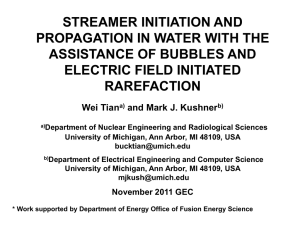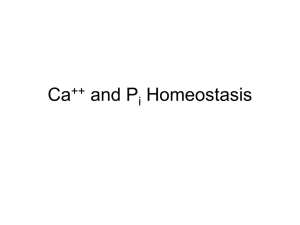GEC2012_Andy_v04 - Mark Kushner Group
advertisement

ATMOSPHERIC PRESSURE PLASMA TRANSFER OF JETS AND BULLETS ACROSS DIELECTRIC TUBES AND CHANNELS* Zhongmin Xiong(a), Eric Robert(b), Vanessa Sarron(b) Jean-Michel Pouvesle(b), Mark J. Kushner(a) (a) University of Michigan Department of Electrical Engineering and Computer Sciences Ann Arbor, MI 48109 zxiong@umich.edu, mjkush@umich.edu (b) GREMI, CNRS-Polytech’Orléans, 45067 Orléans Cedex 2, France eric.robert@univ-orleans.fr, vanessa.sarron@univ-orleans.fr jean-michel.pouvesle@univ-orleans.fr 65th Gaseous Electronics Conference 2012, Austin, Texas, USA * Work at UoM is supported by the DOE OFES and NSF. Work at GREMI is supported through APR "Plasmed" and ANR Blanc "PAMPA" AGENDA Experimental studies of atmospheric pressure plasma transfer across two perpendicular dielectric tubes. Numerical modeling of atmospheric pressure plasma transfer across two perpendicular dielectric channels Primary ionization wave (IW) with positive polarity: Top-down transfer process, polarity preserving Primary IW with negative polarity: Bottom-up transfer process, polarity reversing Effects of rise-time of the primary IW Concluding Remarks GEC2012 University of Michigan Institute for Plasma Science & Engr. PLASMA TRANSFER EXPERIMENTS Atmospheric pressure plasma transfer refers to the production of an ionization wave (IW) in a tube or channel by impingement on the outer surface of a separately produced IW. X. Lu et al, J. Appl. Phys. 105, 043304 (2009) S. Wu et al, IEEE TPS 39, 2292 (2011) E. Robert et al (GREMI, 2011) V. Johnson et al, IEEE TPS 39, 2360 (2011) GEC2012 University of Michigan Institute for Plasma Science & Engr. PLASMA TRANSFER POSITIVE POLARITY Neon plasma, atmospheric pressure, 10 ns snapshots, filament penetration « filaments » across the transfer pipe No« thin plasma layer » E. Robert et al (GREMI, 2011) GEC2012 University of Michigan Institute for Plasma Science & Engr. PLASMA TRANSFER NEGATIVE POLARITY Neon plasma, atmospheric pressure, 10 ns snapshots Formation of thin plasma layer in the transfer tube plasma « plume » « thin plasma layer » « thin plasma layer » E. Robert et al (GREMI, 2011) GEC2012 University of Michigan Institute for Plasma Science & Engr. TWO DIMENSIONAL PLASMA MODELING Channels filled with Ne/Xe = 99.9/0.1 Channels 4 mm wide, separated by 4 mm in air. 25 kV pulse of either polarity is applied on the powered electrode. The pulse rise-time varies from 25 to 400 ns. The pulse duration is 100 ns. Initial electron density [e] in the lower (transfer) channel is [e]0 = 1 x 107 (cm-3). Surrounding air is treated as dielectric material (e = 1). The mole fraction of neon is computed using ANSYS FLUENT v.12.0. GEC2012 University of Michigan Institute for Plasma Science & Engr. MODELING PLATFORM: nonPDPSIM e ( q j N j ) Poisson’s equation: j N j Transport of charged and neutral species: Surface charge: t S q j S t j material Electron temperature: 3 5 ne kTe / t S Te LTe kTe Te Te 2 2 Radiation transport and photoionization: Sm (ri ) N m (ri ) k GEC2012 mk Ak ri exp lk N l rj 'drj ' l r ' j 3 G r ' , r j i N k rj ' Gk rj ' , ri d rj ' 2 4 rj 'ri University of Michigan Institute for Plasma Science & Engr. POSITIVE POLARITY Se AND [e] Electron impact ionization source Se, electron density [e], and electric potential contours (spacing = 2 kV) Plume from primary tube charges the top surface of the transfer channel. Plasma in the transfer channel develops from top to bottom. GEC2012 Animation Slide University of Michigan Institute for Plasma Science & Engr. POSITIVE POLARITY TRANSFER PROCESS (I) Primary IW front crosses the gap at speed of 7 x 107 cm/s. IW in primary channel “shorts” out the electric field, translating applied potential to surface of transfer tube with additional charging of surface of transfer tube. Large E/N in transfer tube ignites the secondary IWs. Two secondary IWs propagate sideways and gradually fill the whole width of the channel. The peak electric field is associated with IW front due to the space charge effect. E-field penetrates the dielectric wall with minor distortion. GEC2012 University of Michigan Institute for Plasma Science & Engr. POSITIVE POLARITY TRANSFER PROCESS (II) Initial electron avalanche in the transfer channel starts directly underneath where IW from primary channel intersects. Transferred avalanche front propagates downwards and sideways. Electrons inside the transfer channel are heated even before the primary IW front impinges on the top surface. Electric potential expands following the propagation of the primary/secondary IWs. The secondary IWs are driven by the same polarity as that of the primary IW. GEC2012 University of Michigan Institute for Plasma Science & Engr. POSITIVE POLARITY COMPARISONS Contours of time integrated Ne* density in the simulation show a similar shape to the plasma emission image in the experiments. Positive plasma transfer is thus a top-down process and the secondary IWs preserve the polarity of the primary IW. Time integrated Ne* density (University of Michigan) GEC2012 Plasma emission in experiments (GREMI) University of Michigan Institute for Plasma Science & Engr. NEGATIVE POLARITY Se AND POTENTIAL Electrons are deposited by the primary IW on the top transfer channel wall. Plasma inside the transfer channel develops from bottom to top. Positive electric potential emerges in the transfer channel. GEC2012 Animation Slide University of Michigan Institute for Plasma Science & Engr. NEGATIVE POLARITY [e], AND POTENTIAL A positive IW emerges from the bottom of the transfer tube and impinges upon the top wall. A positive charge layer forms underneath the top transfer channel wall, turning the negative potential (dash line) into positive potential (solid line). GEC2012 Animation Slide University of Michigan Institute for Plasma Science & Engr. NEGATIVE POLARITY TRANSFER PROCESS Initial electron avalanche in the transfer channel starts from the bottom wall. A positive IW front propagates upwards and then impinges on the top wall. The impingement of the positive IW front forms a strong positive charge layer on the top inner surface. The space charge layer generates positive potential inside the transfer channel. The secondary IWs are driven by the potential with a reversed polarity of the primary IW. GEC2012 University of Michigan Institute for Plasma Science & Engr. NEGATIVE POLARITY COMPARISONS Both simulations and experiments show the existence of an intensive plasma layer underneath the inner top wall. Negative plasma transfer is thus a bottom-up process and the secondary IWs reverse the polarity of the primary IW. Time integrated Ne* density (University of Michigan) GEC2012 Plasma emission in experiments (GREMI) University of Michigan Institute for Plasma Science & Engr. EFFECTS OF PULSE RISE-TIME Negative IWs are more sensitive to the pulse rise time than positive IWs . Increasing pulse rise-time slows down both primary and secondary IWs. For a negative primary IW, a threshold in its rise-time exists beyond which secondary IWs can not be generated. GEC2012 University of Michigan Institute for Plasma Science & Engr. CONCLUDING REMARKS Experiments demonstrate atmospheric pressure plasma transfer by the impingement of a plasma jet produced in a source tube onto the outer surface of a transfer tube which is electrodeless and not connected electronically to the source tube. For positive polarity, plasma transfer is facilitated by a direct penetration of the electric field through the tube wall. For negative polarity, it is characterized by the formation of a thin space charge layer inside the transfer tube. Two dimensional numerical modeling with two channels demonstrates that for a positive primary IW, the secondary IWs are produced in a topdown process and preserve the polarity of the primary IW. For a negative primary IW, the secondary IWs are produced in a bottomup process and reverse the polarity of the primary IW. Longer rise-time of the voltage pulse induces a slowing down of both primary and secondary IWs. For a negative primary IW, there is a threshold risetime beyond which secondary IWs can not be generated. GEC2012 University of Michigan Institute for Plasma Science & Engr.







